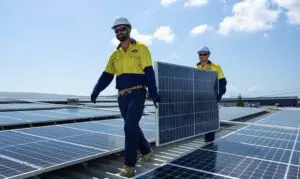Australian developed technology that allows solar cells to be printed out and attached to most surfaces is almost ready for market, the CSIRO has said.
CSIRO’s senior research scientist Dr Fiona Scholes said the technology – which consists of a ‘solar ink’ designed to convert sunlight into electricity – was approaching commercialisation stage, and could be used to power anything from laptops to rooftops.
The Victorian Organic Solar Cell Consortium behind the project – including scientists from the CSIRO, the University of Melbourne and Monash University – has been developing the technology since 2007.
 A commercial printer at the CSIRO office in Clayton, Victoria, which has been modified to take the solar ink, has been working on prototypes of the solar cells for years now, to improve their efficiency.
A commercial printer at the CSIRO office in Clayton, Victoria, which has been modified to take the solar ink, has been working on prototypes of the solar cells for years now, to improve their efficiency.
(Currently, the printed cells are 10 times less efficient than standard silicon solar panels, but the team hopes to improve on that.)
The printer deposits a fine layer of the solar ink onto a material, like plastic, and then attached to a variety of surfaces or objects.
For windows, the solar ink can achieve a semi-transparent effect, tinting the glass while enabling it to generate electricity. Smaller sized printouts can to be used to charge devices like smartphones and laptops.
The CSIRO has had the solar cells successfully generating energy of the roof of its Clayton office for the past 18 months.
According to Fiona Scholes, who heads up integrated systems and devices at CSIRO’s manufacturing flagship, any plastic surface can be substituted for solar panels using the technology – making it perfect for powering a skyscraper, she said.
“We print them onto plastic in more or less the same way we print our plastic banknotes. Connecting our solar panels is as simple as connecting a battery.”
Dr Scholes says several companies, including leading Australian solar dye cell manufacturer, Dyesol, had expressed interest in helping to commercialise the technology.
“We can’t manufacture them here, but we are at the point where they can be taken up by a manufacturer,” Scholes told Guardian Australia.
“It would be wonderful if we could achieve a similar power delivery at significantly reduced cost. Silicon is falling in price, but think about how cheap plastic is. The ink is a negligible cost, so the raw materials are very cost effective.
“This is a big step forward because you can put these cells anywhere you can think of. Also the consistency is better than silicon – they work well in cloudy conditions.”
Funding for the project has been provided by the Victorian government and the Australian Renewable Energy Agency (Arena).
The team is now working on a solar spray coating.







